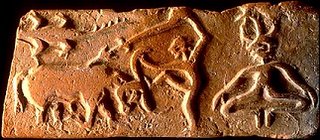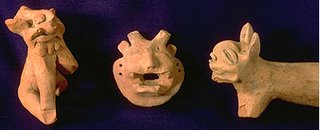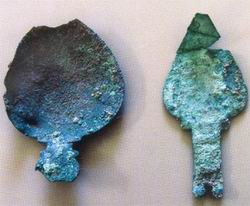
Jiroft. Brass tools.
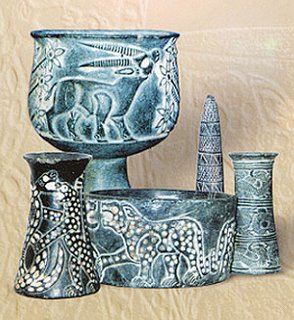
Jiroft. Epigraphs.

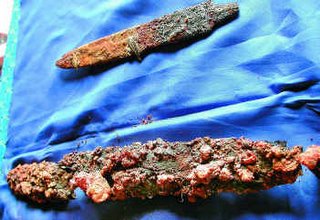

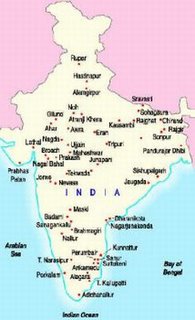
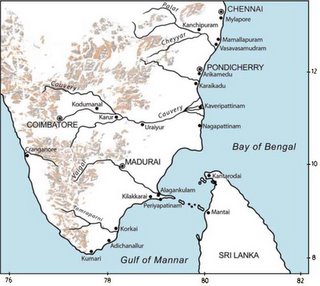 Repertoire of a smith/smithy at Adichanallur and at Jiroft
Repertoire of a smith/smithy at Adichanallur and at JiroftTwo series of epigraphs are presented: one is a potsherd from a funerary urn at Adichanallur; the other are a set of epigraphs on stone vessels at Jiroft. Both series are relatable to Sarasvati hieroglyphs (
http://spaces.msn.com/members/sarasvati97) Both the series are relatable to the continuum of rebus writing system using glyphs to denote property items, metals, minerals, alloys, furnaces, in particular – all products and possessions of a smithy or mint.
The glyphs in the two series are: quiver (with arrows), bird; woman; antelope; monitor lizard
- Jiroft. Antelope, snake, tiger. ranku 'antelope', 'liquid measure'; read rebus: ranku 'tin'. kol = tiger (Santali) kol ‘pancaloha, alloy of five metals (Ta.) http://sarasvatismithy.blogspot.com/ na_ga `serpent' (Sanskrit) na_ga `lead' (Sanskrit)
- Adichanallur. Lizard: kuduru d.okka = a kind of lizard (Pa.)(DEDR 1712) kuduru = a goldsmith’s portable furnace (Te.) DEDR 1712 Pa. kudur ḍokka a kind of lizard. Go. (A. Ko.) kudur d.okke id.; (Mu.) kudur d.ekke garden lizard; (Ch.) kidri d.okke house lizard ( Voc. 753).
bat.a = a kind of iron (G.lex.)
bhat.a = a furnace, a kiln; it.a
bhat.a a brick kiln (Santali)
bat.a = a quail, or snipe, coturuix coturnix cot; bon.d.e bat.a = a large quail; dak bat.a = the painted stripe, rostraluta benghalensis bengh; gun.d.ri bat.a = a small type, coloured like a gun.d.ri (quail); ku~k bat.a = a medium-sized type; khed.ra bat.a = the smallest of all; lan.d.ha bat.a = a small type (Santali.lex.)
bat.ai, (Nag.); bat.er (Has.); [H. bat.ai or bat.er perdix olivacea; Sad. bat.ai] coturnix coromandelica, the black-breasted or rain-quail; two other kinds of quail are called respectigely: hur.in bat.ai and gerea bat.ai (Mundari.lex.) vartaka = a duck (Skt.) batak = a duck (G.lex.) vartika_ = quail (RV.); wuwrc partridge (Ash.); barti = quail, partridge (Kho.); vat.t.aka_ quail (Pali); vat.t.aya (Pkt.); bat.t.ai (N.)(CDIAL 11361). ranku 'antelope', 'liquid measure'; read rebus: ranku 'tin'. kola 'woman' (Nahali, Assamese); rebus: kol 'pancaloha, alloy of five metals'; kollan 'smith' (Tamil) There is a place close by Adichanallur called Salem which is rich in iron ore. The hill there is called kolli malai. Rebus: CDIAL
3944 khōli— f. ‘
quiver’ (Skt.) P.
khol f. ‘sheath, case’; Ku.
khol ‘covering’; N.
khol ‘sheath’, B.
khol, kho
lā; Or.
khoḷi ‘
quiver’,
khoḷā ‘sheath’, H.
khol m.; — G.
khoḷiyũ n. ‘quilt’; M.
khoḷ m.f. ‘pillow- case, mattress cover’. DEDR
2133 Ta. kol working in iron, blacksmith;
kollan blacksmith.
Ma. kollan blacksmith, artificer.
Ko. koll smithy, temple in Kota village.
To. kwall Kota smithy.
Ka. kolime, kolume, kulame, kulime, kulume, kulme fire- pit, furnace; (Bell.; U.P.U.)
konimi black- smith; (Gowda)
kolla id.
Koḍ. kollë black- smith.
Te. kolimi furnace.
Go. (SR.)
kollusānā to mend implements; (Ph.)
kolstānā, kulsānā to forge; (Tr.)
kōlstānā to repair (of plough- shares); (SR.)
kolmi smithy (
Voc. 948).
Kuwi (F.)
kolhali to forge.
This a potsherd from a burial urn containing bones. At this site, remains of living quarters (rampart wall, potters' kilns, a smith's shop) have been found.
It is reasonable to assume that this potsherd from the funerary urn is relatable to the smith. If the assumption is valid, the glyphs depicted on the potsherd may relate to the repertoire of the smithy or the property items owned by the smith or the professions performed by the smith. The epigraph found on a potsherd is a remarkable evocation of Sarasvati hieroglyphs. The glyphs included in this epigraph are: bird, stack of paddy, woman, antelope, alligator or lizard.
The photo with vases and cups discovered at Jiroft depicts: antelope, tiger fighting snakes, two tigers face to face. All these are Sarasvati hieroglyphs ! I am sure there would also be artefacts related to early metalwork. It will be nice to access additional info.on:The albums of Sarasvati epigraphs and decipherment of Mleccha (Meluhha) related to smithy, mint are at
http://spaces.msn.com/members/sarasvati97It has been demonstrated that the Adichanallur picture of a potsherd from a funerary urn is also related to smithy; all glyphs are Sarasvati hieroglyphs: sheaf of paddy, bird, woman, antelope and lizard (alligator?)
Megalithic sites in Bharat
Adichchanallur, (ca. 1st cent. BCE) has yielded bronze bowls, pots, highly ornamental cylindrical jars and a huge bronze vase stand decorated with four rams having long horns which radiate from the centre of the vase base. (Alexander Rea
, Catalogue of the Prehistoric Antiquities from Adichchanallur and Perumbalur, Madras Government Museum, Madras, 1915). Vijaya Ramaswamy notes: “The
perumpanattrupadai describes the kollan (blacksmith) blowing the bellows made of fine animal skin.(
Perumpanattrupadai 199-200 and 206 in
Pathupattu ed. P.V. Somasundaranar, Saiva Siddhanta Kazhagam, Tirunelveli, 1971).The Jain religious epic
Perungadai uses the burning of raw metal in the furnace as a poetic metaphor for mental purification. (
Perungadai cited in S. Velusami, ‘Tamil Nagarigattil Irumbin Pangu’ (in Tamil) in R. Nagasamy ed.,
Tamil Nattu Varalattru Karutharang, Varalattru Peravai, Chennai, 1979, p. 201.)The raw iron mixed with sand was heated along with coal. The sand used in the smelting process was of a special variety.”
“Among the artefacts discovered at the burial site were a profusion of red ware, black ware, black-and-red ware, copper bangles, copper ear-rings, iron spear-heads, terracotta lids with tiered knobs, terracotta vessels that could be used both as lids and as bowls, globular vessels and long-necked utensils. There were vases, pots with exquisite decorations, broken daggers and swords made of iron. There were also Neolithic celts, iron implements, urns with clan marks and urns with hooks inside…Three copper bangles and some copper chisels were also found at the site. Outside, around the urns, were bigger pots, which were red ware. Iron implements, knives, daggers, spearheads and Neolithic celts used in farming were found around the urns. Some pots rested on ring stands of different shapes. The lids came in different shapes - conical, globular, and so on. More than a thousand pot-vessels were unearthed intact. Lots of terracotta beads in conical shape and hop-scotches were found…Satyamurthy called the Adichanallur burial site "the earliest site in Tamil Nadu" and was sure that its history would go back to 1,000 B.C. "In our excavation, we have come across a culture earlier to the megalithic period. It is a well-stratified culture. The pottery is typologically different from that of megalithic pottery," he said. (According to archaeologists, the Iron Age in South India stretched between 1,000 B.C. and 300 B.C. The Iron Age and the megalithic age were contemporaneous in South India. The Iron Age signifies the beginning of civilisation).”
http://www.flonnet.com/fl2213/stories/20050701000106500.htm"Adichanallur, District Tuticorin, Tamil Nadu: The excavation at this megalithic burial site yielded three phases of urn burials confined to a single cultural horizon and revealed more than 160 urns within an area of 600 square meters. Apart from a significant number of skeletal remains, pottery assemblage comprising black-and-red ware, black ware and red ware was also recovered. Besides, iron objects including spearherads, swords, knives, celts and chisels, copper bangles, terracota and stone beads, etc. were duly documented."
http://indiaculture.nic.in/indiaculture/pdf/Annual0405.pdfVijaya Ramaswamy further observes: “It is noteworthy that iron and bronze melting techniques in South India have shown a remarkable degree of continuity. Hamilton Buchanan, writing around 1800, describes iron and steel smelting at Chennimalai in Salem district in an almost identical manner and says that the special sand was obtained from Viracholapuram in Gangeyam district. Iron was then sold in the form of blocks or steel frames. See Buchanan, Hamilton, Francis,
A Journey from Madras Through the Countries of Mysor, Canara and Malabar, 2 vols., London, 1807. The section on mining in the Salem district in volume one contains the above information.”
http://www.india-seminar.com/2003/523/523A small copper image of a Goddess has been discovered in the urn-burials of Adichchanallur. (K. V. Raman,
Sakti Cult in Tamil Nadu—a Historical Perspective (paper presented at a seminar on Sakti Cult, 9th session of the Indian Art History Congress at Hyderabad, in November 2000 ; in press; loc.cit.
http://micheldanino.voiceofdharma.com/tamilculture.html )
(image placeholder)
Bridle equipment recovered from excavations in India.(After Ill. 2 in: LS Leshnik, 1971, Some early Indian horse-bits and other bridle equipment,
American Journal of Archaeology, Vol. 75, 145). a. Timurgarh (7th -6th c. BCE); b,h,m Taxila; i. Navadatoli; j. Kolhapur; k. Sambhar; l. Rairh; n. Nagpur (1st c. CE); o. Adichchanallur; p. Jadigenahalli (2nd-1st c. BCE); q. Guntakal (1st-2nd c. CE).
See Item O. This is a bridle equipment recovered at Adichchanallur. http://www.hindunet.org/saraswati/harness02.jpg
“The objects from
Adichchanallur include diadems, bowls, cups with various animal and bird topped. The animals shown are dog, cock, deer etc. They are shown singly or collectively. Some of the diadems were covered with gold leaf. Incised geometrical and embossed dots are found decorating these vases. Chemical analysis of the objects show 23% of tin. It is believed that the objects were locally manufactured and not imported.”
http://www.intamm.com/culture/hara.htm S. Gurumurthy, Harappa and Tamil Culture
See the location map of jiroft, not far from the coastline of Gulf of Makran and Persian Gulf, close to Tepe Yahya (another Sarasvati civilization site) and Meluhha: http://www.saudiaramcoworld.com/issue/200405/images/Jiroft_map9-lg.jpg
See pictures of metal artefacts (ladle and arrowhead) at: http://www.payvand.com/news/05/jan/1105.html This URL refers to the site as with industrial workshops. Brass works have been found at the site ! Sarasvati hieroglyphs !
"They recently discovered the oldest known commercial seal, estimated to be about 5000 years old, at the historical site of Jiroft. The seal, which bears the image of a goat with its head leaning back, was discovered near the governmental structure of the site during the third stage of excavations.The 2x2cm marble seal was skillfully made, indicating that the region was a developed economic center 5000 years ago." This is a claim made in this news report. While a detailed report and a replica of the seal is awaited, the fact that the glyph is goat with its head leaning back shows two things: 1. that the goat could be read as ran:ku 'antelope'; rebus: 'tin (ore)'; 2. that the leaning back of the head could be read as krammara 'head turned back'; rebus: karma_ra 'smith'.
Another report says that the glyph is "a goat with the head turned around to look back."
http://www.iran-daily.com/1383/2185/html/art.htmhttp://www.hindunet.org/saraswati/chank/salsak1.jpg This is thepicture of a famous seal of Sarasvati civilization. See the goat withits head turned backwards depicted on the pedestal of the seated yogi.This orthography of an antelope looking backwards is repeated on anumber of inscriptions, including the one found on a s'ankha seal atBet Dwaraka.
http://www.hindunet.org/saraswati/chank/salsakwa.htmIranian archaeologist Yusef Majidzadeh believes that Jiroft is the ancient city of Aratta, which was described as a great civilization in an Iraqi clay inscription. See also: http://www.smithsonianmag.si.edu/smithsonian/issues04/may04/iran.html
"Jiroft Inscription", Oldest Evidence of Written LanguageJan 12, 2006
Studies by five linguists from the United States, France, Russia, Denmark, and Iran on a discovered inscription in Jiroft indicate that this Elamit script is 300 years older than that of the great civilization of Susa. Archeologists believe that Jiroft was the origin of Elamit written language in which the writing system developed first and was then spread across the country and reached Susa. The discovered inscription of Jiroft is the most ancient written script found so far.The city of Jiroft is situated close to Halil Rud historical site. Halil Rud, located on the basin of Halil Rood River enjoyed a rich civilization. Many stone and clay objects as well as other historical evidence belonging to the third millennium BC have been discovered during the archeological excavations and also the illegal diggings by the smugglers in this area. 120 historical sites, including that of Jiroft, have been identified in the basin of the 400 kilometer length of Halil Rud River. According to archeological studies, the history of Halil Rud area goes back to some 3000 years ago. The discovered stone dishes in the area belonging to the first half of the third millennium BC point to the developed art of carving on stones at that time."Five Elamit professional linguists from different countries have studied the brick inscription discovered in Jiroft. According to the studies, they have concluded that this discovered inscription is 300 years older than that found in Susa; and most probably the written language went to Susa from this region. However, more studies are still needed to give a final approval to this thesis," said Yousof Majid Zadeh, head of archeological excavation team in Jiroft. "This inscription was discovered in a palace. Although it is not yet known which Elamit king this inscription belongs to, it is definitely an Elamit inscription. More studies are needed to determine the exact time in which it was inscribed, but most probably it is the most ancient written language. Further excavations are being carried out to find the rest of the inscription. However, what is obvious about this discovered inscription is that it is older than the Elamit inscription of Susa," explained Majidzadeh.
The inscription was carved on a brick, and only the lower left corner of it has been remained. Although only two lines with a few words are remained intact on this inscription, there is no doubt that it is an Elamit written script. The most famous Elamit script is the Susinak inscription which was unearthed during archeological excavations in Susa. This inscription is most probably left from the reign of Susinak, Elamite king who ruled during the second half of the first millennium BC. .Elamit language is only partly understood by scholars. It had no relationship to Sumerian, Semitic or Indo-European languages, and there are no modern descendants of it. After 3000 BC the Elamits developed a semi-pictographic writing system called Proto-Elamit. Later the cuneiform script was introduced.Archeological excavations are being carried out in north and south shores of the Halil Rud River in order to discover different dwellings and cemeteries in the region. The wide plundering of the historical and archeological relics by the smugglers led to the lost of a lot of these invaluable evidences. Most of these historical relics were taken out of the country. Although Iran is trying to redeem them, some of those who have collected these relics refuse to give them back claiming that these articles were not made in Iran and thus don't belong to this country. Iranian archeologists are trying to discover more evidence to prove Iran’s possession over these historical objects.
http://www.iranian.ws/iran_news/publish/article_12225.shtmlS. Kalyanaraman, Ph.D. 14 January 2006
kalyan97@gmail.com http://www.hindunet.org/saraswati http://protovedic.blogspot.com/
